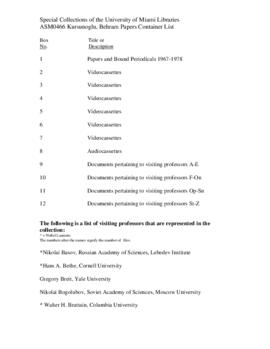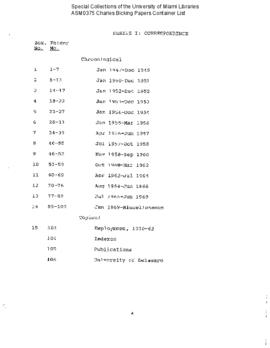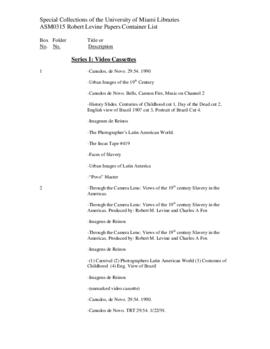Dr. Behram Kursunoglu was the Chairman of the Board for the Center for Theoretical Studies at the University of Miami. The papers consist of letters of communication between Kursunoglu and the professors that lectured at the Center to faculty and students, research plans, video-cassettes and audio-cassettes of the lectures, and publications containing the text of the lectures. Many of the lectures concerned high energy physics, theoretical chemistry, neurosciences, nuclear physics, and issues pertaining to energy problems. Among notable participants were the physicists and Nobel Laureates Albert Einstein, Richard Feynman, Robert Oppenheimer, Francis Crick, and Murray Gell-Mann; the member of the Florida House of Representatives Dante Fascell; and Richard Kennedy, the U.S. Ambassador At Large for Nuclear Energy.
The following is a list of visiting professors that are represented in the collection:
(*=Nobel Laureate
The numbers after the names signify the number of files. )
*Nikolai Basov, Russian Academy of Sciences, Lebedev Institute
*Hans A. Bethe, Cornell University
Gregory Breit, Yale University
Nikolai Bogolubov, Soviety Academy of Sciences, Moscow University
*Walter H. Brattain, Columbia University
Jocelyn Bell Burnell, Cambridge University
H.B.G. Casimir, Phillips, Eindhoven, Netherlands
Britton Chance, University of Pennsylvania
*Leon Cooper, Brown University
Jean Couture, Former Sec. of Energy for France
*Francis H.C. Crick, Salk Institute
Richard Dalitz, Oxford University
*Hans G. Dehmelt, University of Washington
*Max Delbruck, of California Tech
*P.A.M. Dirac (16), Cambridge University
Freeman Dyson (2), Institute for Advance Studies, Princeton
*John C. Eccles, University of Buffalo
*Gerald Edelman, Rockefeller University, NY
*Manfred Eigen, Max Planck Institute Gottingen
*Albert Einstein (2), Institue for Advance Studies, Princeton
*Richard Feynman, of California Tech
*Paul Flory, Stanford University
*Murray Gell-Mann, of California Tech.
*Donald Glaser, Berkeley, UniversityCal
Thomas Gold, Cornell University
Marvin Goldberger, Princeton University
Gerson Goldhaber, Berkeley, University of California
Maurice Goldhaber, Berkeley, University of California
*Gerhard Herberg, NRC of Canada
*Robert Hofstadter, Stanford University
Fred Hoyle, Cambridge University
Erdal Inonu, Ankaro University, Turkey, Currently Foreign Minister of Turkey
Leopold Infeld, Warsaw, Poland
D. Ivanenko, Moscow University
Max Jammer, Bar Ilan University, Israel
Nicolas Kemmer, University Edinburgh
Richard Kennedy, US Ambassador At Large for Nuclear Energy
*Tjallinq Koopmans, Yale University
Alan D. Krisch, University of Michigan
*Willis Lamb, Jr. (2), Yale University
Joseph E. Lannutti, Fla. State University
*Leon Lederman, Ferni Laboratory
Benjamin W. Lee, Ferni Laboratory
J.G. Linhart, ISKRA, Italy
Bernard Lipman (2), Harvard University
Franklin Long, Yale University
Sydney Meshkov, US Bureau of Standards
Elliott Montroll, Rochester University, NY
*Robert S. Mulliken, University of Chicago
Yoichiro Nambu, University of Chicago
*Louis Neel, Grenoble University, France
Kazuhiko Nishijima, Chuo University, Japan
*Lars Onsager, Yale University
Robert Oppenheimer, Former Director of Institute for Advance Studies, and principal architect of the first US atomic bomb
Henry Primakoff(2), University of Pennsylvania
*A.M. Prokhorov, Russian Academy of Sciences, Lebedev Institute
*Theodore I. Rabi, Columbia University
George Rathjens, Massachusetts Institute of Technology
*Norman F. Ramsey, Harvard University
Dixie Lee Ray, Former Governor of the State of Washington, former Chairman of U.S. Atomic Energy Commission
Frederick Reines, University of California, Irvine
Tullio Regge, University Torino, Italy
*Abdus Salam (3), Director, Int'l Center for Theoretical Physics, Trieste, Italy
Edwin E. Salpeter, Cornell University
*Arthur Shavlow, Stanford University
*Julian Schwinger (2), Harvard University
Dennis W. Sciama, Cambridge University
*Glenn T. Seaborg, Former Chairman of US Atomic Energy Commission
Frederick Seitz, Rockafellar University, Former President of the National Academy of Sciences
Robert Serber, Colombia University
Lord Charles P. Snow (4), distinguished author, London
E.C.G. Sudarshan, University of Texas
Edward Teller (4), Known as the father of the hydrogen bomb
*Charles H. Townes, University ofCalifornia at Berkeley
Stanislav Ulam, University Colorado
Georges A.Vendryes, One of the principal architects of the Nuclear Energy Program for France
*George Wald, Harvard University
*Steven Weinberg, University of Texas
Victor F. Weisskopf, Massachusetts Institue of Technology
John A. Wheeler, Princeton University
*Eugene P. Wigner (3), Princeton University
*Kenneth Wilson, Cornell University
Lord Solly Zuckerman, former Chief Scientist to British Government, and distinguished zoologist
Vladimir Zworykin (3), Inventor of TV picture tub, Honorary Vice President of RCA





